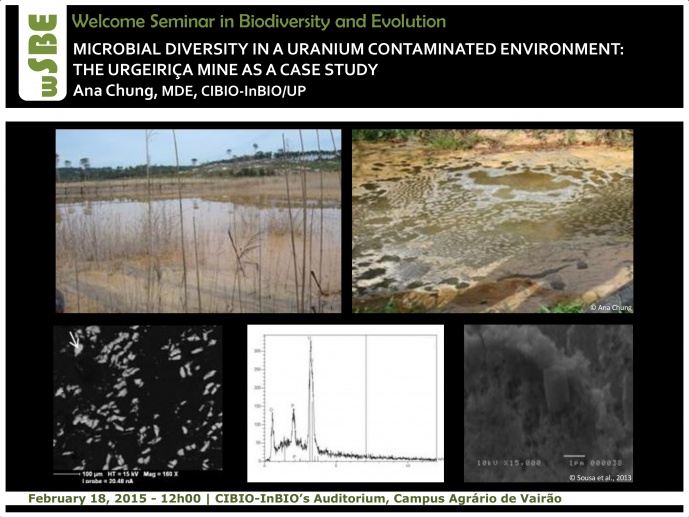MICROBIAL DIVERSITY IN A URANIUM CONTAMINATED ENVIRONMENT: THE URGEIRIÇA MINE AS A CASE STUDY

WELCOME SEMINAR IN BIODIVERSITY AND EVOLUTION

The Urgeiriça mine is currently deactivated, but it was the most important uranium exploration in Portugal. As a consequence of mine activities large amounts of waste was produced (13 Mton) which were deposited in several tailings (Pereira et al., 2004). These chemical hazardous elements as well as radionuclides, can be transferred from the tailing deposits to the surrounding environmental compartments by natural processes. To avoid this possible contamination the Urgeiriça mine is under a program of environmental remediation. Several studies demonstrated that uranium contaminated sites, such as the Urgeiriça mine, often harbor viable and metabolically active microorganisms capable of perform several metal-microbe interactions to maintain viability and can dramatically impact the form and distribution of uranium in environment (Cho et al., 2013; Kumar et al., 2013; Mondani et al., 2011). Therefore, an evaluation of the impact of mining activities on the microbial the diversity of the former Urgeiriça mine was performed by a culture dependent and culture independent approach. Molecular approaches such as pyrotag sequencing and DGGE analysis were employed and also the traditional cultivation methods were used to characterize the heterotrophic aerobic isolates. One of the isolates, Rhodanobacter A2-61 was able to resist and to remove the U (VI) from the culture medium. Different spectroscopic techniques were used to understand the U (VI) removal process and to show the U biomineralization by this Rhodanobacter strain A2-61.
Ana Paula Chung completed her PhD in 2006, at University of Coimbra. Her post-doc research was developed at IMAR-Instituto do Mar, University of Coimbra, on environmental microbiology. Her research interests were focused on microbial diversity of metal/uranium contaminated of environments, identification of key organisms with remarkable metal-interactions abilities and determination of the phenotypic and genetic mechanisms that shape these interactions. In October 2014, she joined the Microbial Diversity and Evolution -MDE group of the CIBIO-InBIO, where she aims to work on microbial diversity, evolution and ecology contributing for the successful fulfilment of the MDE goals.
[Group Leader: Fernando Tavares, Microbial Diversity and Evolution]
Image credits:
Photos by Ana Paula Chung and images from Sousa et al., 2013
References
Cho, K., Zholi, A., Frabutt, D., Flood, M., Tiquia, S.M. (2013). Linking bacterial diversity and geochemistry of uranium-contaminated groundwater. Environ. Technol. 33: 1629-1640.
Kumar, R., Nongkhlaw, M., Acharya, C., Joshi, S. R. (2013). Bacterial community structure from the perspective of the uranium ore deposits of Domiasiat in India. Proc. Natl. Acad. Sci., India, Sect. B Biol. Sci. DOI 10.1007/s40011-013-0164-z.
Mondani, L., Benzerara, K., Carrière, M., Christen, R., Mamindy-Pajany Y, et al. (2011). Influence of uranium on bacterial communities: a comparison of natural uranium-rich soils with controls. PLoSONE 6 (10): e25771. doi:10.1371/journal.pone.0025771.
Pereira, A., Dias, J., Neves, L., Nero, J. (2004). in Proceedings of XI International Congress of the International Radiation Protection Association, p. 10.
Sousa, T., Chung A.P., Pereira, A., Piedade, P., Morais, P. (2013). Aerobic uranium immobilization by Rhodanobacter A2-61 through formation of intracellular uranium-phosphate complexes. Metallomics 5: 390-397.
